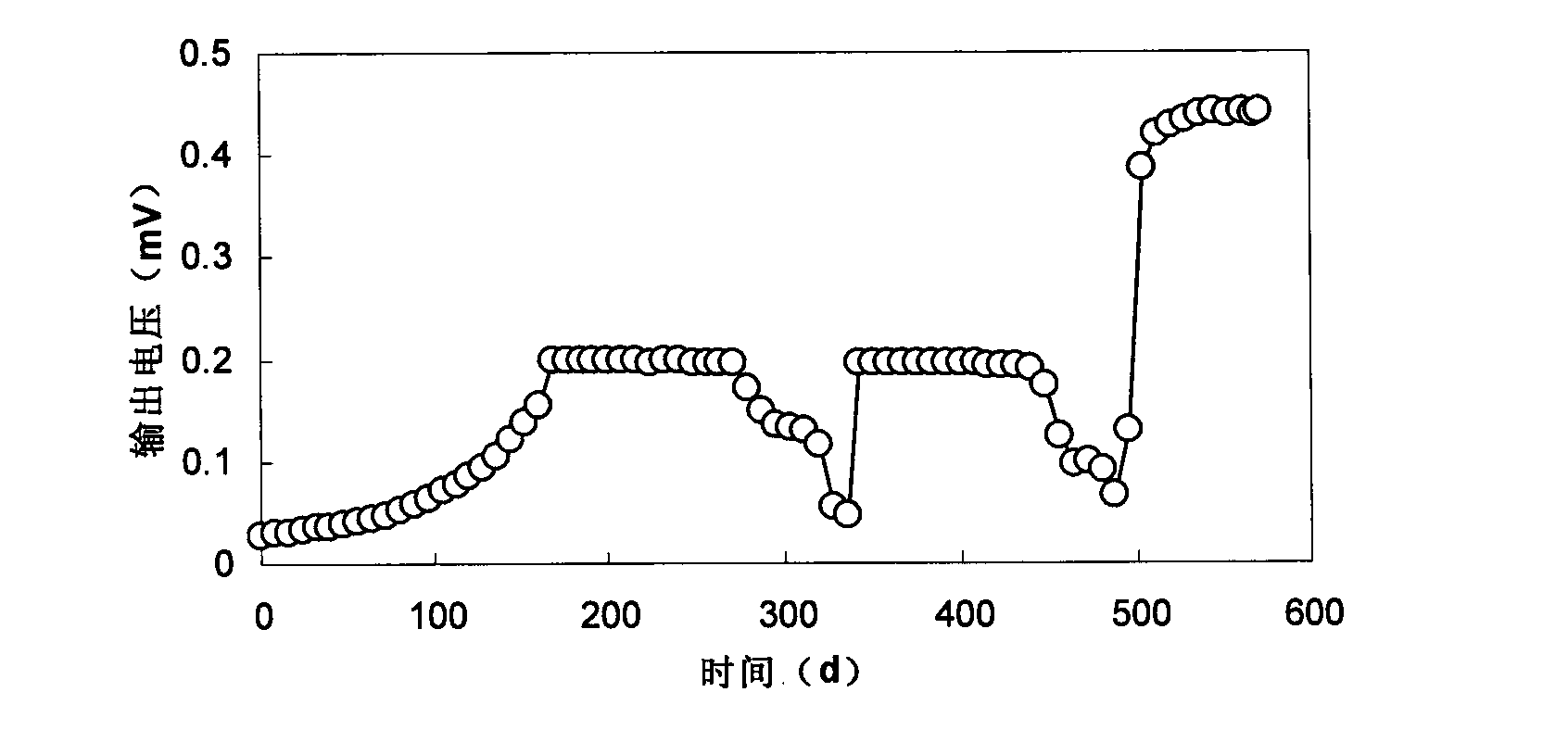Microbe fuel cell inoculation and acclimation starting method for energizing organic waste water
A technology of organic wastewater and fuel cells, applied in biochemical fuel cells, chemical instruments and methods, biological water/sewage treatment, etc., can solve problems affecting the application of microbial fuel cell technology, enrichment and acclimation time of electrogenic bacteria, and too long start-up time and other problems, to achieve the effect of stable domestication process, easy implementation, and low cost of use
- Summary
- Abstract
- Description
- Claims
- Application Information
AI Technical Summary
Problems solved by technology
Method used
Image
Examples
Embodiment 1
[0036] Use microbial fuel cells to treat domestic sewage and recover electrical energy.
[0037] 1) For the preparation of mixed strains, take the soil supernatant, add 1g / L sodium acetate solution to the soil supernatant according to the volume ratio of 10%, and put it in an anaerobic incubator for storage for later use;
[0038] 2) Select a microbial fuel cell with an effective volume of the anode and cathode reaction chambers of 200ml and a distance between the cathode and anode of 5cm;
[0039] 3) Inject 1g / L sodium acetate solution and 150ml and 50ml of the mixed strain solution prepared in step 1) into the anode, and add N, P, and K elements, and the concentrations are 80mg / L, 5000mg / L and 3000mg respectively / L, inject 200ml of 100mg / L sodium nitrate solution into the cathode;
[0040] 4) The 1000Ω resistor is connected to the external circuit, and the wire and monitoring equipment are connected;
[0041] 5) Place it at room temperature until the voltage starts to sta...
Embodiment 2
[0044] The difference from Example 1 is that the treated wastewater is soy sauce brewing wastewater, and volatile gases are regularly discharged during operation.
[0045] 1) For the preparation of mixed strains, take the soil supernatant, add 1g / L sodium acetate solution to the soil supernatant according to the volume ratio of 10%, and put it in an anaerobic incubator for storage for later use;
[0046] 2) Select a microbial fuel cell with an effective volume of the anode and cathode reaction chambers of 200ml and a distance between the cathode and anode of 5cm;
[0047] 3) Inject 1g / L sodium acetate solution and 150ml and 50ml of the mixed strain solution prepared in step 1) into the anode, and add N, P, and K elements, and the concentrations are 80mg / L, 5000mg / L and 3000mg respectively / L, inject 200ml of 100mg / L sodium nitrate solution into the cathode;
[0048] 4) The 1000Ω resistor is connected to the external circuit, and the wire and monitoring equipment are connected...
Embodiment 3
[0052] The difference from Examples 1 and 2 is that the electrogenic bacteria used are collected from activated sludge of a wastewater treatment plant.
PUM
 Login to View More
Login to View More Abstract
Description
Claims
Application Information
 Login to View More
Login to View More - R&D
- Intellectual Property
- Life Sciences
- Materials
- Tech Scout
- Unparalleled Data Quality
- Higher Quality Content
- 60% Fewer Hallucinations
Browse by: Latest US Patents, China's latest patents, Technical Efficacy Thesaurus, Application Domain, Technology Topic, Popular Technical Reports.
© 2025 PatSnap. All rights reserved.Legal|Privacy policy|Modern Slavery Act Transparency Statement|Sitemap|About US| Contact US: help@patsnap.com


